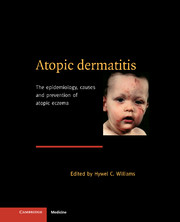Book contents
- Frontmatter
- Contents
- List of contributors
- Foreword Georg Rajka
- Preface
- Part I The nature of the problem
- Part II Descriptive studies which indicate the size of the problem
- Part III Analytical studies which point to causes of atopic dermatitis
- Part IV Intervention studies
- Part V Lessons from other fields of research
- 17 Parallels with the epidemiology of other allergic diseases
- 18 Recent developments in atopic dermatitis of companion animals
- Part VI Conclusions
- Additional information
- Index
- Plate section
18 - Recent developments in atopic dermatitis of companion animals
from Part V - Lessons from other fields of research
Published online by Cambridge University Press: 17 August 2009
- Frontmatter
- Contents
- List of contributors
- Foreword Georg Rajka
- Preface
- Part I The nature of the problem
- Part II Descriptive studies which indicate the size of the problem
- Part III Analytical studies which point to causes of atopic dermatitis
- Part IV Intervention studies
- Part V Lessons from other fields of research
- 17 Parallels with the epidemiology of other allergic diseases
- 18 Recent developments in atopic dermatitis of companion animals
- Part VI Conclusions
- Additional information
- Index
- Plate section
Summary
Introduction
Although atopic dermatitis (AD) is a recognized disease in several animal species, it is best characterized in the dog. In defining the disease, specific clinical and immunological aspects have been variously emphasized. Halliwell & Gorman (1989a) defined canine atopy as an inherited predisposition to develop IgE antibodies to environmental allergens resulting in allergic disease. However, this definition was extended by Scott, Miller & Griffin (1995) to a genetically programmed disease of dogs in which the patient becomes sensitized to environmental allergens that in nonatopic dogs cause no disease. Classically the ‘atopic predisposition’ was considered to be mediated through IgE, but IgG antibodies are now considered important in the pathogenesis of canine AD (Willemse et al., 1985a, 1985b; Hites et al., 1989; Day, Corato & Shaw, 1996). Although Halliwell & Gorman (1989a) considered that the allergic skin disease associated with canine atopy was not a good model for human atopic dermatitis, Willemse (1986) considers it mimics AD of man both clinically and immunologically.
Feline atopic skin disease has been described clinically although complete characterization of reaginic antibodies including IgE in this species has not been documented (DeBoer et al., 1992; Foster et al., 1995). Atopic dermatitis has not been conclusively indentified in horses or domesticated farm animals although reaginic antibodies, IgE and type I hypersensitivity are well documented in horses, cattle, sheep, swine and goats.
Clinical picture
Canine atopic dermatitis
The clinical picture which most clearly approaches that described in human AD is seen in the dog.
- Type
- Chapter
- Information
- Atopic DermatitisThe Epidemiology, Causes and Prevention of Atopic Eczema, pp. 233 - 244Publisher: Cambridge University PressPrint publication year: 2000
- 2
- Cited by

